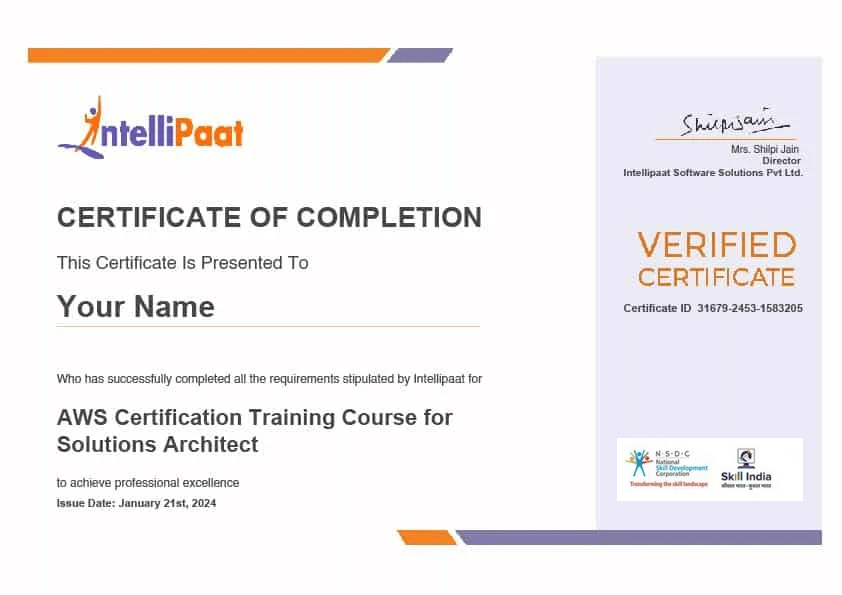Your cart is currently empty.






Become an AWS Certified Professional with our AWS Course in just 2 months!

Watch
Course PreviewIn this AWS training Course, you will learn Cloud Computing and AWS from top AWS industry experts. It will also prepare you for the AWS Solutions Architect Certification Exam.
Here are the skills that you will master in this AWS Solution Architect Course:
Every technology around you uses cloud technologies at the backend. Even this website is hosted over the cloud. LinkedIn states that there are close to 34,000+ jobs in the AWS domain in India. According to AmbitionBox, the average salary of an AWS Solutions Architect in India is 35.7 Lakhs per annum. In the US, it is USD 110,000.
The following are the key learning outcomes of this AWS Solutions Architect Associate course:
There are no prerequisites for this AWS Solution Architect Course. Although, having a hold over programming in any language is a plus.
After enrolling in this AWS training online course, you can apply for numerous jobs in the AWS domain. But the most sought-after job roles based on this AWS certification course are listed below:
Some of the important topics covered in this AWS training course are:
Here are a few reasons why should you join this AWS Certification course:
Overall you get a 360 degree knowledge on AWS that will help you in achieving the AWS Solution Architect Certifications as well as your dream job in the IT industry.
Yes, anyone with a bachelor’s degree and a keen interest in learning cloud computing technology can pursue this certification course.
Talk To Us
We are happy to help you 24/7
59% Average Salary Hike
40 LPA Highest Salary
700+ Career Transitions
300+ Hiring Partners
Career Transition Handbook
*Past record is no guarantee of future job prospects
AWS EC2 and Elastic Beanstalk
Amazon S3
AWS Lambda
AWS Cloudfront
AWS Backup
Database Migration Service
AWS RDS and DynamoDB
CloudWatch and IAM
EBS, EFS, and FSx
ELB, Auto Scaling
Global Accelerator
CloudFormation
OpsWorks
AWS Global Infrastructure
AWS Well-Architected Framework
AWS Command Line Interface
AWS Networking
AWS Security Services
AWS Databases
VPC Networking
AWS Logging Mechanisms
AWS Storage Cost Optimization
EMI Starts at
₹5,000
We partnered with financing companies to provide competitive finance options at 0% interest rate with no hidden costs
Financing Partners
![]()
Contact Us
AWS Training Projects
Here is a pathway that can be followed to prepare for AWS Solution Architect Certification:
Here are the steps to register for the online AWS exam:
The cost of the certification varies, depending on the exam that you register. Here are the following exam fees:
To pass the exam, you need to achieve a score of 720 out of 1000, which is approximately 72%.
Below we have provided some tips to crack the online AWS Solutions Architect exam:
Land Your Dream Job Like Our Alumni
No, it is not mandatory to have coding knowledge to start learning AWS. Although, you will need some basic scripting and programming knowledge as you reach the final modules.
Here are a few job roles that you can apply after the AWS Certification:
The AWS Certification is a globally recognized way to explore different career paths, and also keep you recession-proof. For corporate and IT professionals to validate their technical skills, AWS Online Training is a must. The course helps to upskill and validate one’ expertise to design, deploy, and operate the applications and infrastructure on AWS.
Yes. Intellipaat provides numerous blogs to prepare you for the AWS Solutions Architect Certification. The top free resources available for beginners to clear the exam are AWS Tutorial, AWS Interview Questions and Answers, and all about AWS.
In 2024, the AWS certification will hold much importance, specifically in the layoff-driven job market. The good part is that AWS professionals are quite popular in the cloud field, and much in demand across all sectors. As per LinkedIn, over 140,000 jobs are open for professionals with AWS expertise.
According to AmbitionBox, the average salary of an AWS Cloud Engineer is INR 35.7 Lakhs per annum in India while USD 1,10,000 in the United States.
Yes. There are other cloud competitors in the industry i.e. Google Cloud Platform (GCP) and Microsoft Azure. They do provide their official certification which can act as a substitute to the AWS Certification.
Of course. Intellipaat conducts practice tests to help learners test their knowledge and skills in the domain.
Yes, the course is entirely based on hands-on experience that will provide industry-based project experiences. The labs are aligned with industry standards and requirements that will help you clear the online AWS Certification exam and become an AWS Certified solutions architect.
After completing this best AWS training course, you can explore greater career opportunities through our Advanced Certification in Cloud Computing and DevOps Course at IIT Guwahati. This course will give you a deeper understanding of Cloud Computing on AWS and DevOps.
The preparation for the online AWS Certification exam takes around 40 hours.
Once you complete the online exam, your score will appear on the screen. You will also receive mail on your registered email-id. The detailed transcript of your results will appear in the “Achieved Certifications” section within five days of completing the exam.
Intellipaat offers query resolution, and you can raise a ticket with the dedicated support team at any time. You can avail yourself of email support for all your queries. We can also arrange one-on-one sessions with our support team If your query does not get resolved through email. However, 1:1 session support is given for 6 months from the start date of your course.
Intellipaat provides placement assistance to all learners who have completed the training and moved to the placement pool after clearing the PRT (Placement Readiness Test). More than 500+ top MNCs and startups hire Intellipaat learners. Our alumni work with Google, Microsoft, Amazon, Sony, Ericsson, TCS, Mu Sigma, etc.
No, our job assistance is aimed at helping you land your dream job. It offers a potential opportunity for you to explore various competitive openings in the corporate world and find a well-paid job, matching your profile. The final hiring decision will always be based on your performance in the interview and the requirements of the recruiter.














 Click to Zoom
Click to Zoom